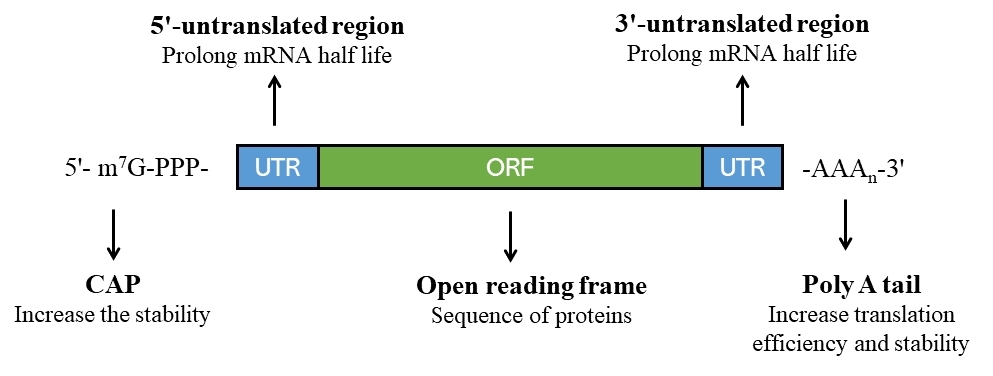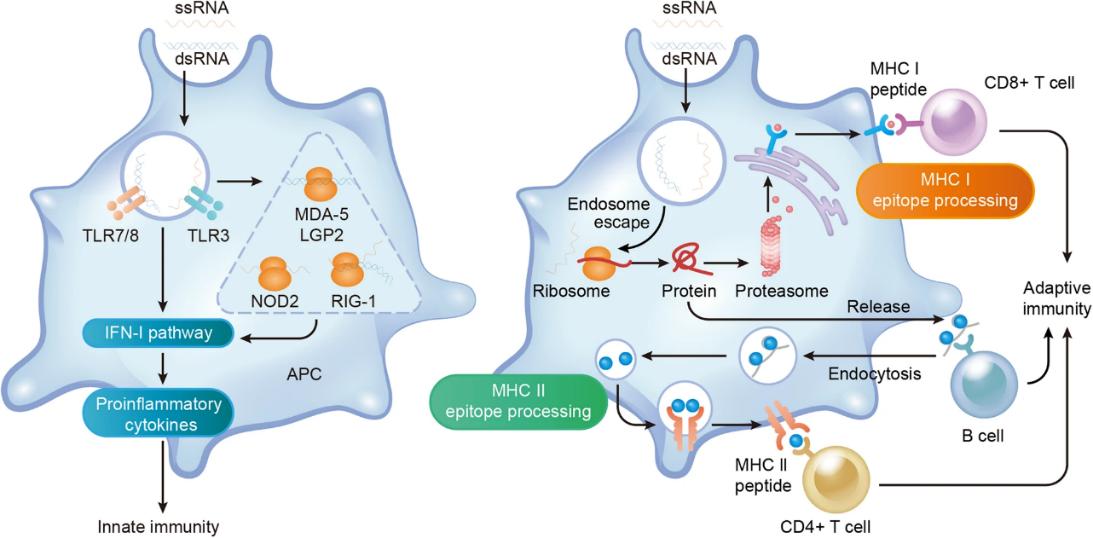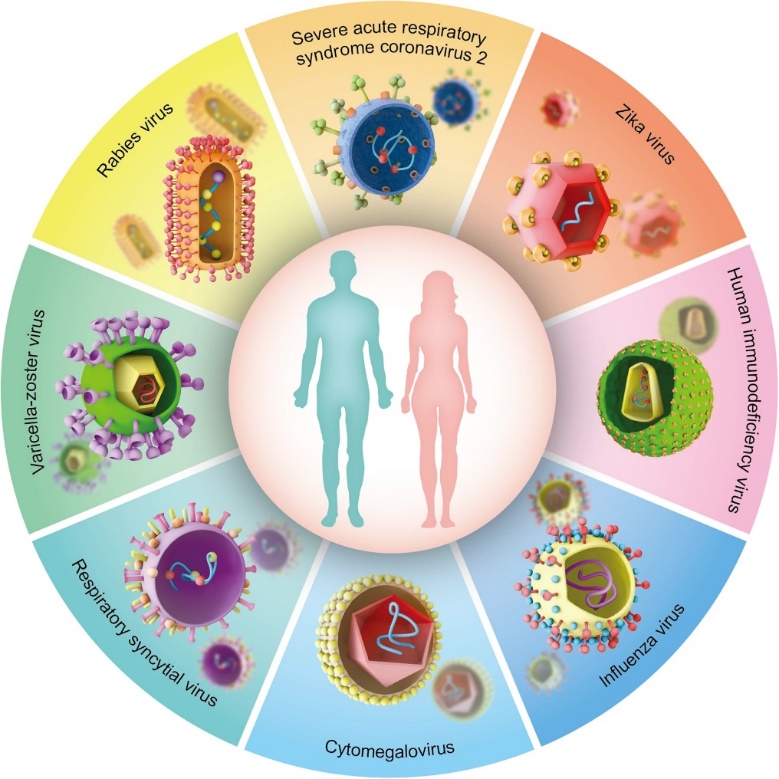What Is mRNA?
Messenger RNAs (mRNAs) are single-stranded molecules in cells that transfer genetic information from the DNA in the nucleus to the cytoplasm, where proteins are synthesized (in the ribosomes). mRNAs are a group of RNAs that can be translated into proteins, while other RNAs cannot. Because nearly every function in the organisms is carried out by one or many proteins, mRNA is just as critical as DNA. The sequence of mRNA can be interpreted using next-generation sequencing (NGS). Transcriptomics using RNA-seq can explore the sequence and function of mRNA.
mRNA is different from RNA. RNA, a class of biological macromolecules, comprises several types such as mRNA, tRNA, and rRNA, among others. Of these, messenger RNA, or mRNA, plays a pivotal role in cellular functions, primarily by transcribing genetic information from DNA and guiding the amino acid sequence on the protein chain in ribosomes.
Service you may intersted in
mRNA Structure
Within biological organisms, the structure of mRNA typically consists of several components, including the 5′ end, the coding region, the 3′ untranslated region, and the polyadenylate tail or Poly-A tail.

Figure 1. Schematic representation of the mRNA structure
In prokaryotes (organisms lacking a distinct nucleus), mRNAs contain a transcribed copy of the DNA sequence with a terminal 5′-triphosphate group and a 3′-hydroxyl residue. In eukaryotes (organisms containing a clearly defined nucleus), the structure of mRNA molecules is more elaborate. The 5′-triphosphate residue is further esterified, forming a cap structure. The 3′ ends typically contain a poly(A) tail that consists of multiple adenosine monophosphates and is added enzymatically after transcription. Eukaryotic mRNA molecules, usually composed of introns and exons, are subjected to a process of cleavage and rejoined from an original precursor mRNA. In general, due to the lack of the poly(A) tail and the cap structure, prokaryotic mRNAs are less stable than eukaryotic mRNAs and degraded very rapidly.
mRNA Function
In cellular function, mRNA, or messenger RNA, is of paramount importance across transcription, transportation, translation, regulation, cell signaling and beyond. Converted from the genetic information in DNA, it transcribes this data into an RNA format. Control elements in the framework of mRNA, including the cap at its 5′ end and the polyadenylate tail at the 3′ end, facilitate mRNA’s transportation from the cell nucleus to the cytoplasm via nuclear pore complexes.
A primary role of mRNA is to serve as a template for translation, guiding ribosomes in the cytoplasm to translate codons present on it into the corresponding amino acid sequence for protein synthesis. Intriguingly, some mRNA molecules exhibit intrinsic cell signal modulation functionality, possibly participating in gene expression regulation in the intracellular environment.
Stability, transcription level, and translational efficiency of mRNA may be subject to internal and external cellular regulation. These regulatory mechanisms include RNA modifications, RNA-binding protein associations, interference by microRNAs, among others, all of which can potentially influence the function and expression level of mRNA.
The central dogma is the flow of genetic information from DNA, to RNA, and to protein. Because DNA cannot be decoded directly to produce amino acids, mRNAs act as an intermediary between DNA and protein. Each piece of mRNA encodes the information for one protein in eukaryotes (or more than one protein in prokaryotes). During translation, ribosomes use the instructions conveyed by mRNA as a template for recruiting and assembling the amino acids to create the desired peptides/protein. Every three nitrogen-containing bases in the mRNA directing the incorporation of a particular amino acid within the protein or the termination of the translation process. In addition to mRNA, two other major types of RNA also take part in protein synthesis, which are ribosomal RNA (rRNA) and transfer RNA (tRNA). rRNA is the component of ribosomes. tRNA is responsible for carrying specific amino acids to the ribosome.
mRNA and Disease
Within biological organisms, aberrant expression or mutations of messenger RNA (mRNA) can potentially contribute to the onset and progression of numerous diseases. For instance, hereditary diseases such as cystic fibrosis and ataxia are associated with mRNA abnormalities. Also, irregular mRNA expression is a common phenomenon during the development of various cancers.
In the context of autoimmune diseases such as rheumatoid arthritis and systemic lupus erythematosus, the dysregulation of mRNA within immune cells can lead to an imbalance in immune regulation, triggering inflammation and subsequent tissue damage. Moreover, in neurodegenerative diseases like Alzheimer’s and Parkinson’s, the mRNA within neural cells may influence neuron functionality and survival, which in turn can result in neurological dysfunction.
mRNA expressions also play a significant role in certain infectious diseases like influenza and AIDS, as viral infections can alter host-cell mRNA synthesis, thereby promoting viral replication and transmission. Bio-markers derived from mRNA can aid in potential drug candidate screening and assess therapeutic efficacy and safety.
In recent decades, the concept of mRNA vaccines has evolved from a subject of skepticism to a clinical reality. The COVID-19 pandemic in 2020 hastened the swiftest vaccine development in history, propelling mRNA vaccines to the forefront of these endeavours. It is empirically observed that vaccines play a pivotal role in mitigating the spread of infectious diseases, availing the preservation of countless lives annually. The extensive application of vaccines in the past several decades has eradicated smallpox while simultaneously reducing the prevalence of poliomyelitis, measles, and other infectious diseases to near negligible levels.

Figure 2. Dual effects of mRNA vaccine on immune activation. (Zhang et al., 2023)
The current range of available mRNA vaccines embraces infectious diseases, cancer, autoimmune diseases, tissue injury, and rare diseases, manifesting the versatility and potential of mRNA vaccines across diverse therapeutic domains. However, apart from anti-COVID-19 mRNA vaccines, few vaccines have hitherto been approved for disease treatment. There remain certain challenges yet to be fully resolved, potential hindrances to the broader application of mRNA vaccines.

Figure 3. Landscape of mRNA vaccines in infectious diseases. (Zhang et al., 2023)
References:
- Darnell J E. mRNA structure and function//Progress in nucleic acid research and molecular biology. Academic Press, 1977, 19: 493-511.
- Langstrom N S, Anderson J P, Lindroos H G, et al. Alzheimer’s disease-associated reduction of polysomal mRNA translation. Molecular Brain Research, 1989, 5(4): 259-269.
- Seko Y, Cole S, Kasprzak W, et al. The role of cytokine mRNA stability in the pathogenesis of autoimmune disease. Autoimmunity reviews, 2006, 5(5): 299-305.
- Wang E T, Taliaferro J M, Lee J A, et al. Dysregulation of mRNA localization and translation in genetic disease. Journal of Neuroscience, 2016, 36(45): 11418-11426.
- Howells D W, Porritt M J, Wong J Y F, et al. Reduced BDNF mRNA expression in the Parkinson’s disease substantia nigra. Experimental neurology, 2000, 166(1): 127-135.
- Chaudhary N, Weissman D, Whitehead K A. mRNA vaccines for infectious diseases: principles, delivery and clinical translation. Nature reviews Drug discovery, 2021, 20(11): 817-838.
- Zhang G, Tang T, Chen Y, et al. mRNA vaccines in disease prevention and treatment. Signal Transduction and Targeted Therapy, 2023, 8(1): 365.

Leave a Reply